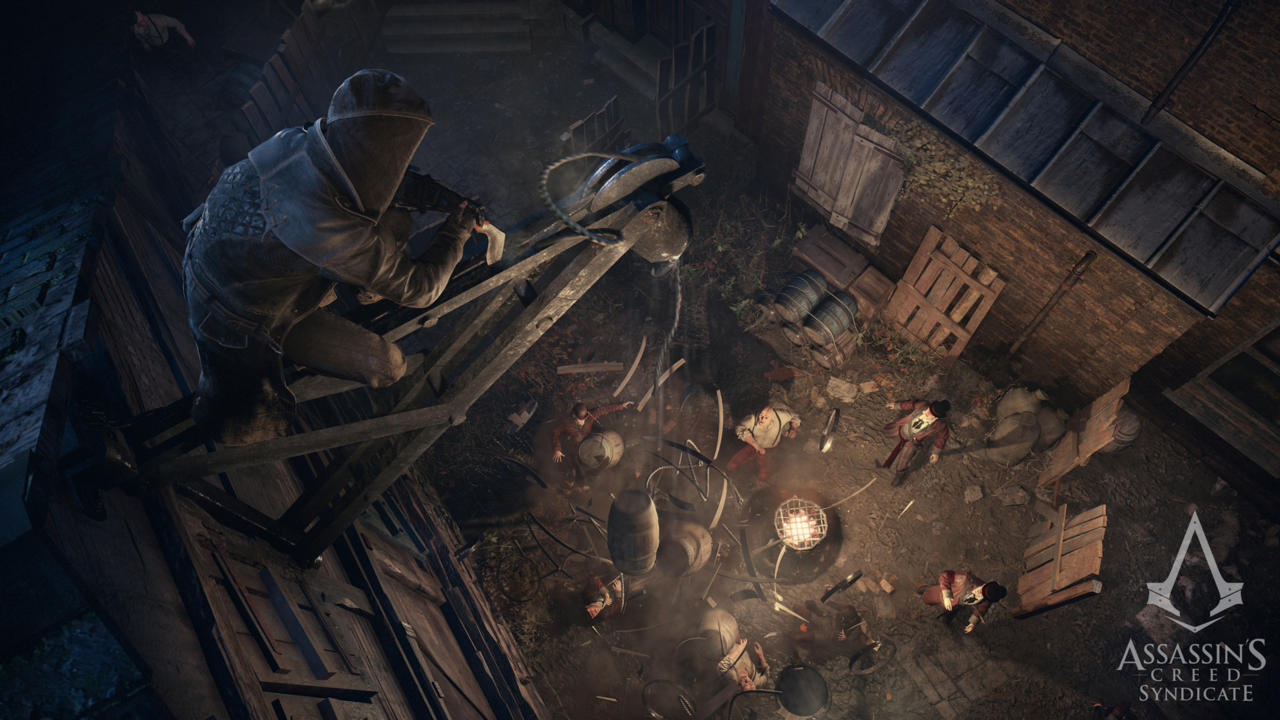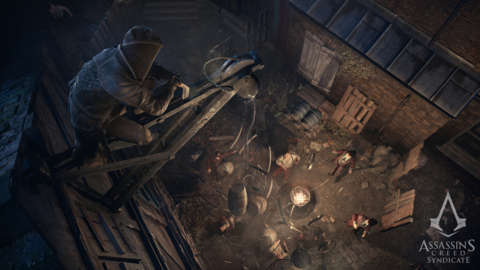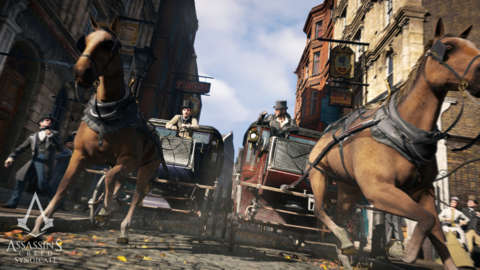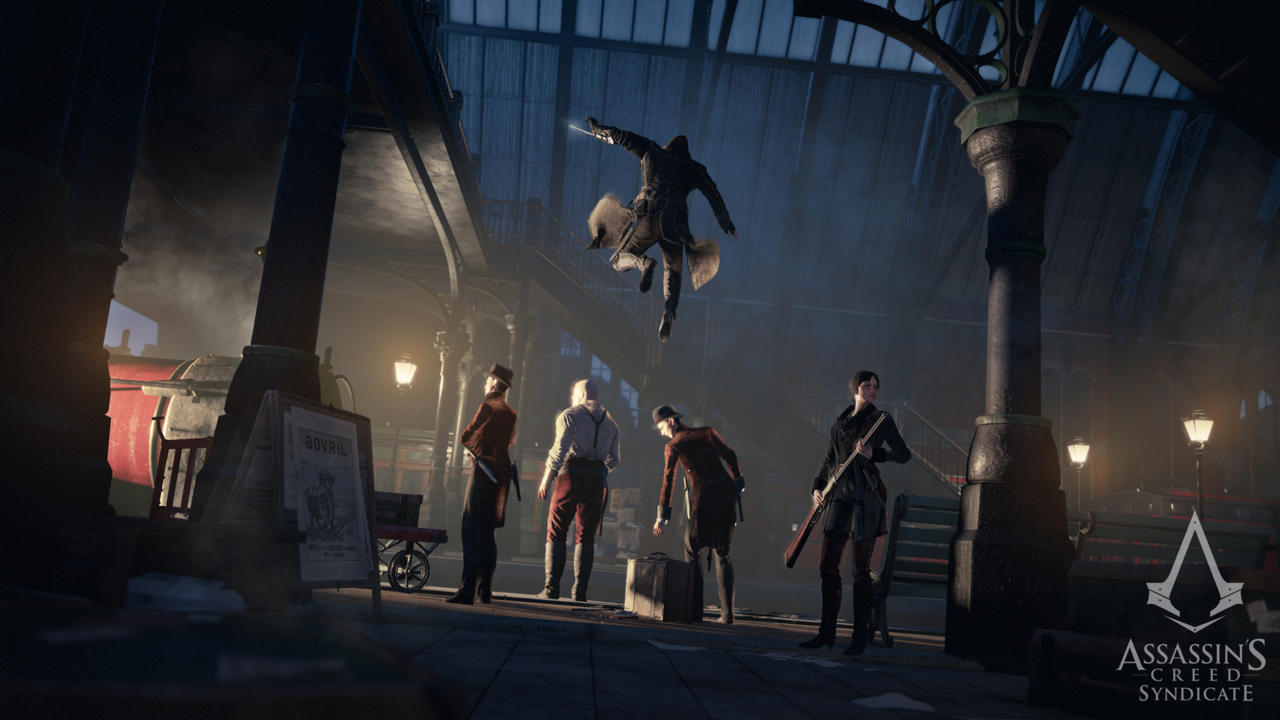We've broken up our preview into two parts. If you want our spoiler-free impression of the combat, keep reading. Check out part two for a full run-down of the story, setting, and characters in Syndicate.
In addition to bringing the franchise to an all-new location with a new set of heroes, Assassin’s Creed Syndicate is retooling the franchise’s long-standing combat system.
It’s clear that developer Ubisoft Quebec has invested much in its vision of 1868 London, creating a world that is as boisterous as protagonists Jacob and Evie Frye. Players will explore the city’s seven boroughs, overthrowing opposing crime lords and building an underground Assassin-led network hellbent on destroying Templar control. It’s the first title in the series set in the modern era, giving developers a perfect opportunity to modernize the game’s systems as well.

The way Assassin’s Creed titles have handled stealth of this point revolve around available cover, and you had to base your sneaking around on the presence of hay bales and bushes and blending into crowds. Stealth was based on hiding and taking refuge, waiting out enemies and staying unseen. In Syndicate, the hard snap is gone, and you won’t be spending your time painstakingly trying to meld into groups of people. In the London underground, there’s no need to hide who you are.
In Syndicate, stealth abandons the need to hide entirely and instead focuses on allowing players to manipulate the environment in ways that allow them to sneak around. The game features more physical stealth, the same crouching and crawling mechanics used in more recent action-adventure games. You won’t be hitting buttons to enter and exit cover; instead there will be a "softer snap," in which you can tap a button to move fluidly from navigation into stealth when you need it.
Assisting players in this new kind of stealth is the whistle, which was been brought back from previous Assassin's Creeds for use in Syndicate. A soft whistle from Jacob will lure unsuspecting police and criminals to wherever he is hiding, allowing him to dispatch them quickly and quietly away from crowds. Throwing knives have also been made more versatile. In addition to throwing them at enemies, they can be used to cut down objects hanging over the London streets, like barrels and cargo in nets, and chucked into fire sources to inflict burns on enemies and cause a distraction.

Feeding back into the new stealth mechanics, creative director Marc-Alexis Cote noted that navigation has been developed to be smoother in order to accommodate the removal of cover-based sneaking and the addition of new items like the rope launcher. Cote also noted that, after complaints about windows being too hard to move over and into in Unity, windows in Syndicate have been retooled for smoother use. You’ll also be able to climb up more things; chimneys, for one, offer an excellent point on which to get a great view of the city.
During a presentation of the game, I watched protagonist Jacob climb up one such chimney to get a good look at his next objective. As the camera turned to take in the white beacon shooting into the sky that indicated his next mission, I saw St. Paul’s Cathedral in the distance. Nearer, the factory district was crowned in black smoke, a tiny forest of black chimneys poking into the sullen sky. After one last look Jacob took a leap of faith into a cart full of hay, then trotted out on his way to a brawl.

As for combat, everything has been brought into close quarters. Syndicate focuses on melee combat, with Jacob and his street gang pulling enemies into fist fights on the city streets. The birth of organized crime saw the uptick in use of concealed weapons, making Jacob’s arsenal the perfect set of tools for the time. Combat is no less brutal than in previous games, but bringing fights between you and your enemies closer allows for some seriously cool-looking fast-paced skirmishes. It also shifts the initiative from the AI to the player; you won’t be expecting them to react to you sniping a target or have to wait for them to take turns attacking. Multiple enemies can converge on Jacob simultaneously, making brawls more about crowd control than taking out everyone. Opponents can be stunned or manipulated into taking one another out for you--this is where throwing knives into fire sources can spark fights among your enemy groups. It’s a significantly greater test of the player’s reflexes than it has been in previous games.
Another promising feature is the reworking on all side activities. Rather than have certain fetch quests or mini-missions to gather items or do something frivolous, every activity within the game--every main quest mission and side mission--will feed back into your goal of controlling the city. That means everything you do has some impact, in some small way, on what you’re striving to accomplish. The storyline and the sidequests will intertwine as one, developers say, creating a smooth experience that doesn’t throw any curveballs that break you out of the narrative.
Recruitment goals are back as well, because your ultimate goal is to build Jacob’s underground army of the poor and scrappy of London. Once you’ve amassed followers, you can participate in gangs wars, giant group brawls that take up whole city blocks and soak the cobblestones in blood. The leaders of the boroughs--Templars, of course--will notice when you take over one of their strongholds and show up with their minions to challenge you.
"The fantasy that we have in Victorian London is to become the masters of the criminal underground."
During the presentation, I watched Bloody Nora--the badass leader of one of the boroughs--hunt down Jacob and challenge him to a fight. As she drew her gun to shoot Jacob down in cold blood, his sister Evie, materializing seemingly from nowhere on a rooftop, shot the gun out of Nora’s hand with her rope launcher, prompting Nora to call her gang to her aid.

Like a scene out of Gangs of New York, Jacob and a handful of his men swaggered across a stony square to meet Nora and her men. One of Jacob’s men threw the first punch, and from there it was an all-out brawl. Total chaos. People came from every side to create a mass of flailing limbs and incoherent shouting. A horde of men and women (all in pants, I might add) ran into the square, punching, kicking, and stabbing each other. Within minutes it was all over, the ground littered with bodies and splashes of blood. Jacob emerged victorious, taking out Nora himself and claiming the borough for he and his sister Evie to lead.
"I think the biggest challenge [in making a game] is defining a clear fantasy for our players to engage in, identifying that fantasy and then relating everything to it," Cote explained. "The fantasy that we have in Victorian London is to become the masters of the criminal underground. Then we can attach a lot of things to this. You use the criminal underground to take back the control of London. It fits super well within the open world, with the concept of dominating the map and London. On the other end, we can use the main storyline to explore the different ways the Templars are controlling the city and use your gang to fight that."
For more details on Assassin's Creed Syndicate, read up on everything we know so far.
Take a closer look at Assassin's Creed Syndicate in the screenshot gallery below.













